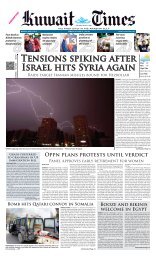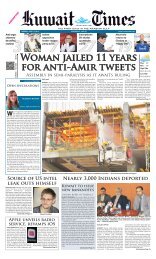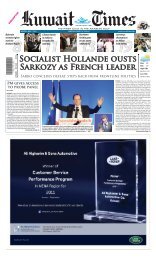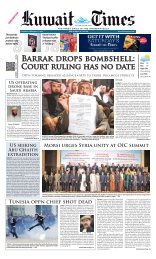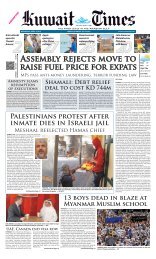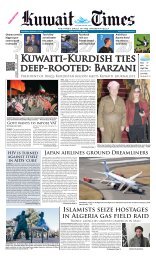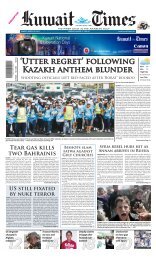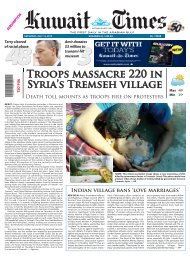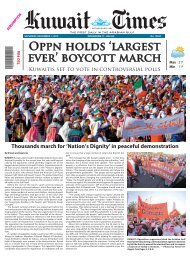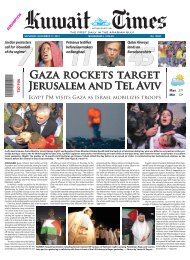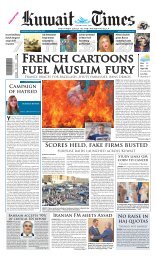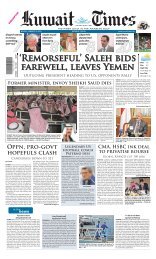ARAb StAtES diSMAyEd At WESt'S cOMPlAcENcy - Kuwait Times
ARAb StAtES diSMAyEd At WESt'S cOMPlAcENcy - Kuwait Times
ARAb StAtES diSMAyEd At WESt'S cOMPlAcENcy - Kuwait Times
You also want an ePaper? Increase the reach of your titles
YUMPU automatically turns print PDFs into web optimized ePapers that Google loves.
SATURDAY, MAY 4, 2013<br />
Qatar extends buying spree to<br />
India with $1.3bn Bharti deal<br />
Deal pushes India ahead of China<br />
NEW DELHI/DUBAI: Gulf state Qatar<br />
has bought a 5 percent stake in Indian<br />
telecoms firm Bharti Airtel Ltd for<br />
$1.26 billion, the firm said yesterday,<br />
extending an overseas buying spree<br />
from mainly developed countries to<br />
Asia’s third-largest economy. The deal<br />
is being channelled through Qatar<br />
Foundation Endowment and a source<br />
close to QFE said it would be an active<br />
investor in Bharti Airtel, securing a<br />
board seat at the world’s fourthbiggest<br />
mobile phone company by<br />
customers.<br />
“QFE is in for the long-term,” the<br />
source said, speaking on condition of<br />
anonymity. The purchase by QFE - an<br />
investment vehicle of the Qatar<br />
Foundation controlled by Sheikha<br />
Mozah, the second wife of the country’s<br />
Amir - pushes India ahead of<br />
China to top Asia’s inbound league<br />
table for mergers and acquisitions this<br />
year. According to Thomson Reuters<br />
data, India’s inbound M&A now totals<br />
$9.83 billion so far this year, compared<br />
with China’s $7.7 billion and<br />
Australia’s $6.9 billion. Qatar’s first<br />
major investment in a listed Indian<br />
company provides Bharti Airtel with<br />
much-needed capital that strengthens<br />
its balance sheet and future growth.<br />
LONDON: China, Russia and Kazakhstan are among the<br />
few trade allies still providing a lifeline to Iran’s vital steel<br />
and iron ore sector after most Western suppliers and buyers<br />
have cut ties due to growing sanctions pressure. While<br />
industry data shows steel imports have more than halved<br />
in the last year, Tehran has kept an inflow from some partners<br />
and slightly boosted domestic production of the<br />
material, used in construction and vehicle production but<br />
also potentially for nuclear use and munitions.<br />
Iran has also doubled exports of the steelmaking raw<br />
ingredient iron ore, worth about $3 billion a year at current<br />
prices. The country does not have enough capacity to<br />
use much more of its ore to produce steel, but exporting it<br />
provides much-needed income now its oil revenues are<br />
down by about 50 percent due to sanctions over its disputed<br />
nuclear programme.<br />
“This only allows Iran to ease the pain or offset some of<br />
the effects of what is happening because of sanctions. It<br />
does not enable them to overcome the sanctions,” said<br />
Scott Lucas, founder of the EA WorldView news site.<br />
“The Iranians are having to go to a shrinking number of<br />
customers to try and look for this increase in exports like<br />
iron ore to compensate for sharp drops in its main product,<br />
which is oil,” said Lucas, whose site provides analysis<br />
on Iran. While EU and US bans on specific ferrous products<br />
have pushed most Western players away, fearing repercussions<br />
on their international trade, Chinese interest in<br />
Iranian iron ore has increased, and China has increased<br />
steel supplies to Iran.<br />
Top steel producer China is now buying about 2 million<br />
tonnes of Iranian iron ore a month, double the amount it<br />
was buying in early 2012, data from consultancy the<br />
International Steel Statistics Bureau shows. “The growth in<br />
exports is absolutely true ... (The business) is growing from<br />
an infant to a small child,” said a spokesman for the Iran<br />
Iron Ore association. It is not yet a “key form of income at<br />
Bharti’s profit has fallen for three<br />
years in a row, hit by fierce competition<br />
in its main Indian market.<br />
Controlled by billionaire Sunil Mittal<br />
and also nearly a third owned by<br />
Southeast Asia’s top phone carrier<br />
SingTel , Bharti had $11.7 billion of net<br />
debt, or about 2.5 times its operating<br />
profit, as of end-March. It operates in<br />
20 Asian and African countries and<br />
has about 260 million mobile phone<br />
customers. The investment by QFE, a<br />
recently-established arm of the Qatar<br />
Foundation, is in line with the gas rich<br />
state’s strategy of picking minority<br />
stakes in large global companies such<br />
as Royal Dutch Shell, Tiffany & Co and<br />
Siemens.<br />
Those deals were made through<br />
Qatar Holding, the investment arm of<br />
the state sovereign wealth fund,<br />
which has emerged as one of the<br />
world’s most prolific investors with<br />
stakes in companies such as London<br />
miner Glencore Xstrata and Swiss<br />
banking giant Credit Suisse. Bankers<br />
close to the sovereign fund say it has<br />
an appetite for $30-$40 billion in global<br />
investments annually.<br />
Separately, the nonprofit Qatar<br />
Foundation has a main mandate of<br />
developing the state’s human capital<br />
and a knowledge-based economy,<br />
although it still owns commerciallooking<br />
investments such as telecoms<br />
firm Vodafone Qatar.<br />
Deal dynamics<br />
As part of the deal Bharti will issue<br />
199.9 million new shares at 340 rupees<br />
each, a 7.3 percent premium to the<br />
stock’s Thursday closing price, the<br />
company said yesterday. The telco’s<br />
shares closed 0.3 percent higher on<br />
Mumbai’s National Stock Exchange,<br />
having risen as much as 4.7 percent in<br />
early trade. The stock has fallen 4 percent<br />
in the last three months.<br />
The deal “should help ease the debt<br />
burden and improve investor confidence”,<br />
said Karan Mittal, a telecommunications<br />
analyst at ICICI Direct in<br />
Mumbai. Bharti, which recently raised<br />
$1.5 billion in overseas bonds, has an<br />
option to sell shares its majority-owned<br />
telecoms infrastructure unit Bharti<br />
Infratel. Bharti Airtel did not sell any<br />
shares when this unit went public last<br />
December. It is also looking to sell up<br />
to a quarter of its satellite television<br />
services arm, sources told Reuters in<br />
March. Goldman Sachs advised Qatar<br />
Foundation Endowment on the Bharti<br />
deal. — Reuters<br />
Trade allies throw lifeline<br />
to Iran’s vital steel sector<br />
this point”, he said, adding that cash was the primary payment<br />
choice. Market participants, however, say much of<br />
the trade now involves barter and funds deposited in<br />
bank accounts in China, South Korea and other countries<br />
that can be exchanged for goods.<br />
Tehran’s ambitious plans<br />
Tehran has ambitious plans to expand domestic steel<br />
output and hopes it can in the short term become self-sufficient.<br />
“Iran is in a position to produce more steel domestically;<br />
they have the technology, energy, iron ore to do<br />
that,” said Edwin Basson, director general of industry body<br />
WorldSteel. Nevertheless, industry experts say it will take<br />
the country many years to become independent from foreign<br />
producers, especially for semi-finished products such<br />
as billet.<br />
“We have enough factories, and they can make anything<br />
they want, but the raw product is often coming<br />
from abroad,” an Iranian property developer said by<br />
phone. While some of the finished products he needs<br />
such as steel beams come directly from China and Russia,<br />
others are manufactured by Iranian companies from billets<br />
coming from abroad, he said.<br />
Iran still has to contend with the dragnet of sanctions,<br />
which is cutting supplies of steel. New US regulations<br />
coming into effect on July 1 are set to tighten metals trade<br />
with Iran. Government sources in South Korea said steel<br />
exports to Iran had decreased a lot and would face<br />
tougher sanctions. “Those who continue to do business<br />
with Iran will face fewer competitors for Iranian business<br />
and will demand a risk premium on exports to Iran and a<br />
risk discount on imports from Iran.<br />
The net impact will be a continued drain on Iran’s foreign<br />
currency reserves,” said Mark Dubowitz, who has<br />
advised President Barack Obama’s administration and US<br />
lawmakers on sanctions. — Reuters<br />
business<br />
MICHIGAN: In this photo, Ford’s Flat Rock Assembly<br />
Plant employees cheer as the millionth Ford Mustang is<br />
driven off the assembly line in Flat Rock, Mich. — AP<br />
Boeing to build<br />
longest-range<br />
passenger jet<br />
PARIS/DUBAI: Boeing has shown airlines a blueprint for the<br />
world’s longest-range passenger jet, adding spice to a longawaited<br />
revamp of its 777 wide-body jet, people familiar<br />
with the matter said. Boeing launched a race against Airbus<br />
for sales of the newest long-haul jets by announcing it had<br />
begun selling an upgraded aircraft family code-named<br />
777X. First seen in the 1990s, the 777 cornered the market<br />
for large twin-engine aircraft able to fly routes previously<br />
only possible with four engines, earning it the nickname<br />
“mini-jumbo.”<br />
Analysts say the 777 is Boeing’s most profitable plane,<br />
thanks largely to the 777-300ER, a 365-seat version that<br />
began operations in 2004. Most of the industry’s attention is<br />
now focused on a future 400-seat version known as the 777-<br />
9X, which is Boeing Co’s response to a growing challenge<br />
from the largest version of Europe’s newest aircraft, the<br />
Airbus A350-1000.<br />
But talks between Boeing and potential buyers have also<br />
generated interest in a 777-8X that would be a successor to<br />
the 777-200LR, the industry’s current distance champion,<br />
with a range of more than 9,300 nautical miles (17,200 km),<br />
people briefed on the talks said.<br />
The 777-8X, boasting a range of 9,500 nautical miles<br />
(17,600 km), would be designed for some of the world’s<br />
longest trips such as from the Middle East to South America.<br />
“They are offering an ultra-long range aircraft in the 777-8X,”<br />
said an industry source briefed on the plans. “It’ll be the<br />
longest range aircraft in the business.” Boeing declined to<br />
comment on specifics, but spokeswoman Karen Crabtree<br />
said the company is working with customers to fine tune<br />
the details. Experts say ultra-long range planes deliver<br />
mixed benefits to airlines and so far the market for them<br />
remains a niche, overshadowed by the juggernauts<br />
designed for trunk routes. That is because when modern aircraft<br />
fly the longest 15-hour flights, the first few hours are<br />
spent mostly burning the fuel needed to carry even more<br />
fuel for the rest of the flight. These aircraft “carry more fuel<br />
to carry more fuel,” said consultant Richard Aboulafia of<br />
Virginia-based Teal Group.<br />
“They need a very big wing with lots of (fuel storage)<br />
capacity, which means lots of structure and weight.” Fuel is<br />
not the only source of extra weight. The long journey times<br />
also mean loading extra meals and a reserve crew, so that<br />
the fuel burned per hour - a measure of efficiency - can end<br />
up greater than if the plane simply stopped en route. Airlines<br />
must balance this against any extra revenue they can charge<br />
for a direct flight and the ability to eliminate the fuel wasted<br />
in climbing and descending twice, as well as en-route landing<br />
fees and other costs linked to a stopover. —Reuters



